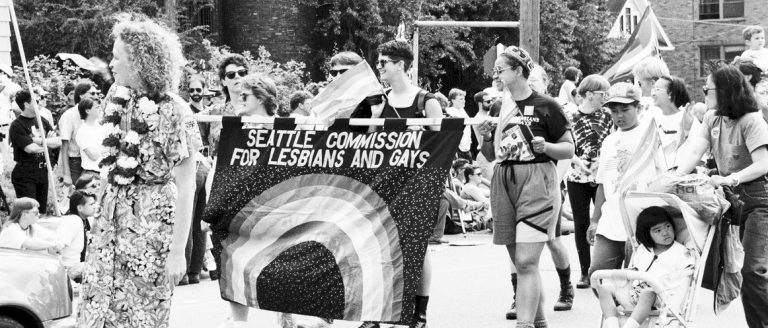Evolution of Seattle’s LGBTQ Historic Neighborhood
Seattle Washington is known for several things. Nature, beautiful sunsets, progressive attitude and for being one of the most friendly LGBTQ+ cities in the world today. While in general the city of Seattle is a LGBTQ+ friendly city, locals will always point to Capitol Hill as the focal point for those seeking gay friendly bars and attractions. Nevertheless, while everyone knows Capitol Hill as the headquarters for the LGBTQ community today, that was not quite the case.
Where did Seattle’s LGBTQ community begin?
Historically speaking, Seattle’s LGBTQ legacy began over 130 years ago. In 1851, Arthur Denny washed ashore with his crew on Alki Point and began to extract resources from the land, mainly timber to build up the economy. In 1880, Seattle had a modest population of about 3,500 people with the growing population consisting mostly of laborers in the timber industry or working various jobs.
The work life of a Seattlite at the time was more transient than permeate for those outside of Seattle’s upper and middle class. Bars, brothels, boarding houses and gambling dens began to pop up on Yesler way, which is now known as Pioneer Square.
During the 1880’s same-sex relations was of no concern in the eyes of the law… that was until 1893 when it was declared a crime. At that time during the 1880’s, the city was building a reputation for its various sexual practices amongst the transient working class and many enter into sexual relations with each other for several reasons:
- Protection
- Gain Material Possessions
- Sexual Release in the absence of Women for the Older Men
The same-sex relationships amongst the transient working class was not labeled as “gay” nor was it labeled as “homosexual” by contemporaries. However, it was seen as a threat to heteronormal and christan family values.
In February 1893, Seattle legislature declared an anti-sodomy law prohibiting same-sex relationships deciding it was an act against nature. While the law that was put into act was vaguely written it stood strong. The punishment resulted in a sentence twice as long as for one who committed heterosexual rape.
Time progressed into 1918, where Lilburn Merrill -a physician- wrote an academic article stratifying the definition of homosexual. It was deemed by him that only men who were emffirmate and desired sex only with other men were commiting an act of crime. His article further stated that young men and youths involved in same sex relations did so for protection and to gain material, but male young youths did want to have sex with women.
When did the LGBTQ Community Emerge in Seattle?
It was not until 1930, when Seattle had a visible gay community in the city and 1933 (end of prohibition) where Seattle began opening bars that catered toward men seeking other men began to open all around Pioneer Square such as “Casino Pool Hall” or as patrons called it “Madame Peabody School of Dance” and “The Double Header” Seattle’s longest operating gay bar until it closed in 2015. Drag shows were performed in these bars and halls as the main feature of the gay community with a majority of performances shown in vaudeville settings.
While there were strict laws in place preventing same-sex relations, these Seattle bars were never raided. Seattle’s Police Force at the time was happily willing to take bribes over searching bars for gay practices. Officers would take bribes of $100 a month to turn a blind-eye to drag shows while taking an additional $50 a week from places that allowed same-sex dancing. It was through the protection of payoffs where Seattle’s gay bar scene erupted in 1960 were bars, clubs and bathouses began opening all over Pioneer Square and expanded into the Central Business District.
Business was taking off so well that even the police bargained with gay business owners MacIver Wells and Jake Heimbigner to open an after hours gay dance club in 1965.
As things progressed into the 1970’s and young gay men started to establish institutions in Capitol Hill, lesbian women began to create their own enclaves in University District stating “gay patriarchy”. Although Pioneer Square was gender inclusive, lesbian feminists and gay liberationists did not agree on everything. The enclaves wanted a women only space to discuss the issues that they faced mainly rape and sexual harassment.
Additionally, some lesbian feminists believed having separatism was crucial when ending male dominance. Tensions grew into the 1980s between parties as gay men inserted a domineering and aggressive masculinity into gay culture all while the Union for Sexual Minorites — A coalition of gay men and women who shared similar anti-racist and anti-imperialist views — believed there needs to be a middle ground as both men and women live in a society.
Capitol Hill the Most Historic LGBTQ Seattle Neighborhood
Seattle’s Capitol Hill: Now and Then
Capitol Hill, as it is today, has grown into the “headquarters” for the LGBTQ+ community in Seattle. The neighborhood is the focal point for the cities pride festival, gay bars such as Union and Wild Rose fill the streets for the local residents, and artists collaborate and create to celebrate the city’s rich history regarding the legal battles, protests and movements.
On June 26th local Seattle artist Christopher Paul Jordan is revealing “The Amp” at the Plaza on Broadway and Denny Way. The sculpture is a lard 20×20 giant X crafted with mirrors on the front while the sides of the structure are various colors. The back of the sculpture is loaded with amps for live DJ performances. The piece is a portal into the spaces of radical gathering, hospitality, celebration, and care that have arisen throughout the history of AIDS
How did Capitol Hill become the new Pioneer Square?
Pioneer Square was the center of entertainment since the late 1800s but as suburbanization was becoming popular for American households across the nation, many mid-to-upper class families began to move out of Capitol Hill. Several large homes were renovated into separate units or became communal homes for young gay families to take hold of. Additionally, the expansion of the black community in South Seattle, put off the more well-to-do white residents of the city and they made their leave. Rent cost plummeted as the rich made their exit allowing more affordable housing for the gay community.
The Union for Sexual Minorities remained active till the mid-to-late 1970s leading the way of politics through their anti-racist and anti-imperialist views, which allowed the community to grow. The organization Black and White Men together worked closely with the Union for Sexual Minorities to continue their fight in a more equitable future.
The fight continues to create a nation that allows for same-sex relations to exist without apology or harassment as groups and organizations form to normalize and integrate gay communities across the United States. During the month of June, people come together in celebration of the achievements and milestones gained in the movement of creating a nation where its culture supports the lifestyle of the LGBTQ and not oppress it.

Greater Seattle Real Estate – 2024 Review
Northwest MLS Real Estate Report Capitol Hill Classic Available for Purchase Are Seattle home prices dropping? The trends of Seattle follow closely what happens across the Northwest Multiple Listing Service.

October 2024 Greater Seattle Real Estate Report
Northwest MLS Real Estate Report Luxury Seattle Home Available for $14.9 Million Is the real estate market, including the greater Seattle real estate market, slowing down? The number of sales

5 Things To Do This May in Seattle
Even though the weather can be a bit unpredictable during spring, there are still plenty of indoor and outdoor activities around the city to enjoy. Here’s our list of 5


